
Egyptian Cedar Wood Sarcophagus Mask, ex-Christie's
Similar Sale History
View More Items in MasksRelated Masks
More Items in Masks
View MoreRecommended Art
View More





Item Details
Description
Egypt, Late Dynastic Period, 26th Dynasty to Ptolemaic period, ca. 664 to 30 BCE. A tall and finely-carved cedar wood sarcophagus mask with strikingly naturalistic features. The mask is defined by its prominent nose with flared nostrils, raised almond-shaped eyes under curved brows, contoured cheeks, full lips with lightly-indented corners, and a narrow chin. The neck extends downwards from the back of the mask, and the smooth pate is covered by a simple rectangular headdress. The flat verso is meant to protect the body and face of the deceased, and a small cavity behind the headdress was formed to hold offerings. Residual dowel holes are scattered across the obverse and reverse sides with fragments of the original dowels in each. Though rough and exposed, this wooden mask is a beautiful example of ancient Egyptian funerary practices. Custom wooden display stand included. Size: 5.5" W x 12" H (14 cm x 30.5 cm); 14.875" H (37.8 cm) on included custom stand.
Mummy masks were principally used to protect the face of the deceased, but they could also act as a substitute for the mummified head in the case of loss or damage. In addition, the ancient Egyptians believed that the "ba" (often incorrectly translated as "spirit") could leave the tomb and travel freely in the world of the living. To make sure that upon returning it would recognize the mummy, whose face was hidden by layers of bandages, the mask functioned as a portrait. Nevertheless, most masks had idealized features and were rarely particularized portraits.
Interestingly, cedar wood was not native to Egypt. Egypt did not have verdant forests filled with tall trees, and unfortunately most of its native lumber was of relatively poor quality. So they relied on importing to acquire hardwoods - ebony from Africa as well as cedar and pine from Lebanon. One fabulous obelisk inscription by Thutmose III attests to the luxury of hardwoods. It reads as follows, "They brought to me the choicest products…consisting of cedar, juniper and of meru wood…all the good sweet woods of God's Land." The rarity of cedar meant that masks like this one were reserved for those who could afford them.
For a stylistically-similar example, please see the Smithsonian National Museum of Natural History, USNM catalog number A553186: https://artsandculture.google.com/asset/-/DgEWydQp4nyZbQ?childassetid=GwHec6DnkhEqvg
Provenance: private Florida, USA collection; ex-Christie's, London, South Kensington Antiquities auction (sale 9244, November 7, 2001, lot 527)
All items legal to buy/sell under U.S. Statute covering cultural patrimony Code 2600, CHAPTER 14, and are guaranteed to be as described or your money back.
A Certificate of Authenticity will accompany all winning bids.
We ship worldwide to most countries and handle all shipping in-house for your convenience.
#140357
Mummy masks were principally used to protect the face of the deceased, but they could also act as a substitute for the mummified head in the case of loss or damage. In addition, the ancient Egyptians believed that the "ba" (often incorrectly translated as "spirit") could leave the tomb and travel freely in the world of the living. To make sure that upon returning it would recognize the mummy, whose face was hidden by layers of bandages, the mask functioned as a portrait. Nevertheless, most masks had idealized features and were rarely particularized portraits.
Interestingly, cedar wood was not native to Egypt. Egypt did not have verdant forests filled with tall trees, and unfortunately most of its native lumber was of relatively poor quality. So they relied on importing to acquire hardwoods - ebony from Africa as well as cedar and pine from Lebanon. One fabulous obelisk inscription by Thutmose III attests to the luxury of hardwoods. It reads as follows, "They brought to me the choicest products…consisting of cedar, juniper and of meru wood…all the good sweet woods of God's Land." The rarity of cedar meant that masks like this one were reserved for those who could afford them.
For a stylistically-similar example, please see the Smithsonian National Museum of Natural History, USNM catalog number A553186: https://artsandculture.google.com/asset/-/DgEWydQp4nyZbQ?childassetid=GwHec6DnkhEqvg
Provenance: private Florida, USA collection; ex-Christie's, London, South Kensington Antiquities auction (sale 9244, November 7, 2001, lot 527)
All items legal to buy/sell under U.S. Statute covering cultural patrimony Code 2600, CHAPTER 14, and are guaranteed to be as described or your money back.
A Certificate of Authenticity will accompany all winning bids.
We ship worldwide to most countries and handle all shipping in-house for your convenience.
#140357
Condition
Small losses to obverse and reverse sides. Minor chips to facial features, verso, and peripheries, with softening to some finer details, and several stable hairline fissures. Light earthen deposits and light patina throughout.
Buyer's Premium
- 24.5%
Egyptian Cedar Wood Sarcophagus Mask, ex-Christie's
Estimate $5,000 - $8,000
4 bidders are watching this item.
Shipping & Pickup Options
Item located in Louisville, CO, usSee Policy for Shipping
Payment

Related Searches
TOP





















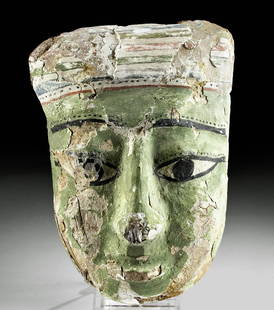


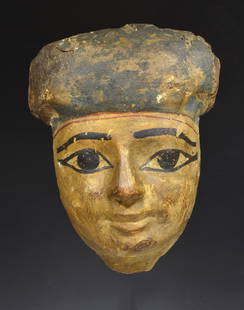







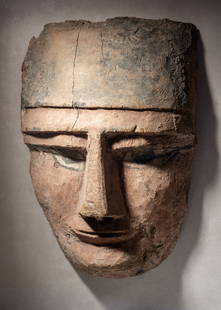
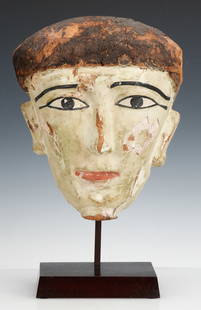

![RAYMOND WILLIAMS, DITIDAHT/NUU-CHAH-NULTH, NORTHWEST COAST, Mask, 1956: RAYMOND WILLIAMS, DITIDAHT/NUU-CHAH-NULTH Mask, 1956 cedar wood and acrylic paint, 12.5 x 7.5 x 3.5 in (31.8 x 19.1 x 8.9 cm) inscribed [date? by the artist???? unknown hand???] in ink, "KETCHIKAN / A](https://p1.liveauctioneers.com/7222/330450/178180773_1_x.jpg?height=310&quality=70&version=1716403015)

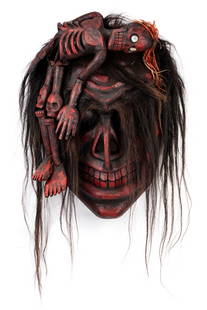



































![[SEX] LOT OF 9 PHOTOGRAPHS SOLD TOGETHER: [SEX] A lot of 9 photographs sold together. Some postcards. One mounted with plastic corners in archival mat. Prints: 4.5" x 3" - 6" x 4". Generally good condition, various imperfections. *Additional](https://p1.liveauctioneers.com/8124/329546/177689790_1_x.jpg?height=310&quality=70&version=1715469494)





![Emilio Grau-Sala "Sur la Plage" Oil on Canvas: Emilio Grau-Sala (Spanish, 1911-1975), "Sur la Plage" [On The Beach], Oil on Canvas, 1958, signed "Grau Sala" lower right, signed, inscribed "Trouville", dated, and titled to verso. Image: 21.5" H x 2](https://p1.liveauctioneers.com/5649/328023/176731071_1_x.jpg?height=310&quality=70&version=1714409606)


